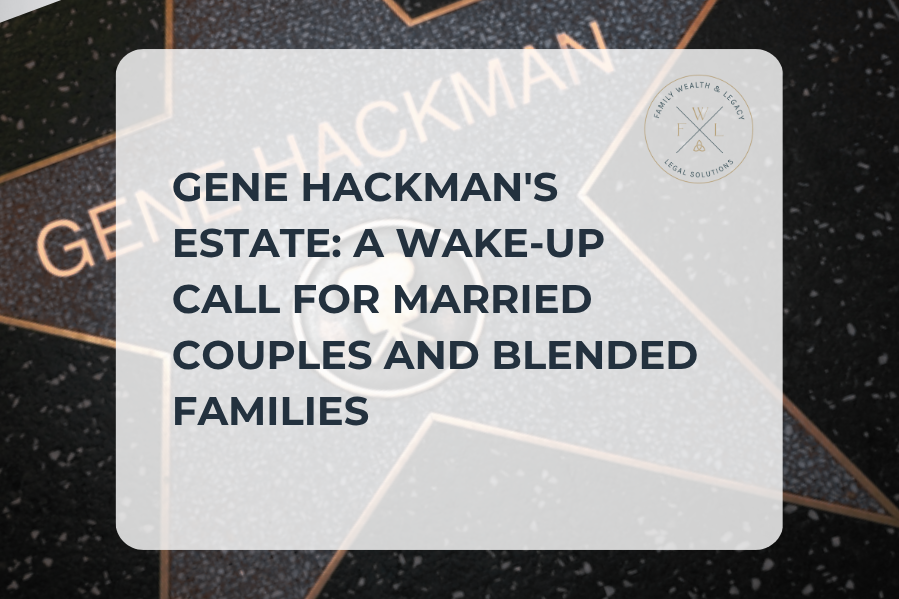The recent passing of legendary actor Gene Hackman and his wife, Betsy Arakawa, within days of each other has sparked headlines and questions that remain unresolved. Beyond the tabloid dramatics lies a very real and relatable lesson about estate planning, especially for married couples and blended families.
According to People Magazine, Hackman’s Will, last updated in 2005, left everything to Arakawa. Similarly, her estate plan left everything to Hackman. Their simultaneous deaths have now placed the administration of both estates in the hands of a successor fiduciary, with Hackman’s three adult children from a previous marriage potentially left out of both estates. The situation is further explored in the New York Post, which questions whether his estimated $80 million fortune will ever reach his children.
Let’s take a closer look at what went wrong—and what every family should do differently.
What Happened
Hackman, 95, died from heart-related complications a week after Arakawa, 65, passed from a rare virus. Their Wills left everything to each other and named each other as the executor and trustee. Unfortunately, the next named fiduciary had also passed, requiring the court to appoint a corporate representative.
Although Hackman lived in New Mexico, here in Illinois we have specific statutes that address what happens when people die close in time. Under 755 ILCS 5/3-1, if there’s no sufficient evidence that two people died at different times, the law treats them as having died simultaneously and their property will be divided with 1/2 going to each person’s closest relatives. This provision helps avoid uncertainty over which estate should receive shared assets.
Further, the Uniform Simultaneous Death Act (USDA) and the Uniform Probate Code require that a beneficiary outlive the decedent by at least 120 hours (five days) in order to inherit — unless the estate planning documents say otherwise. So, Arakawa would be treated as having predeceased Hackman because she died fewer than five days before him. This could drastically change who inherits what, particularly if no clear backup beneficiaries were named.
These laws exist to create clarity — but without the right language in your documents, they can unintentionally disrupt your intentions.
Five Steps to Avoid These Mistakes in Your Own Plan
1. Name Backup Beneficiaries on All Accounts
Your estate plan is only as strong as your weakest asset designation. Even if your trust is well-drafted, outdated or incomplete beneficiary designations can override your intentions.
Read more: 4 Common Mistakes People Make on Their Life Insurance Beneficiary Designations
2. Plan for Simultaneous or Close-in-Time Deaths
Many couples leave everything to each other and stop there. But it’s essential to plan for the possibility that you and your spouse pass away together or within days of each other. Survivorship provisions, clear contingent beneficiaries, and alternate trustees should be in place.
3. Don’t Rely on a Will Alone
Hackman’s outdated Will left everything to Arakawa, and hers did the same. A Will alone, especially an old one, cannot protect against modern complications like blended families, incapacity, or simultaneous death. A properly drafted and maintained revocable living trust is far more flexible and protective. In any thorough and well drafted trust, a “remote contingent beneficiary” is named to address this exact situation.
Read more: Why Just a Will Is Never Enough
4. Update Your Plan Regularly
Hackman’s Will was nearly 20 years old. In that time, the law, your net worth, and family relationships will all inevitably change. Your estate plan should be reviewed every 3 years—or immediately after a major life event—to ensure it still reflects your goals.
Read more: Pitfalls of Estate Planning – 5 Essential Tips
5. Work with an Attorney Who Builds in Ongoing Support
Most lawyers draft documents and send you on your way. But life doesn’t stop changing. At Family Wealth & Legacy Legal Solutions, our planning process includes ongoing reviews so you’re never left with a plan that’s out of date or incomplete.
Book your complimentary 15-minute call
Final Thoughts
Gene Hackman’s estate is making headlines, but the story is not unique. It’s the kind of mess families face every day when their plans are based on assumptions, outdated documents, or incomplete strategies.
Don’t leave your family guessing. Don’t risk unintended disinheritance. And don’t assume that a Will alone will get the job done. Start with a conversation that’s built around protecting your loved ones, honoring your values, and keeping your family out of court and out of conflict.
Schedule your Family Wealth & Legacy Strategy Session now.
If you enjoyed reading this article and made it to the end, please leave a comment and let us know your thoughts and your biggest takeaway. If you think your family and friends could benefit, please share it on social media to spread the word.
This article is a service of Family Wealth & Legacy Legal Solutions (FWLLS). At FWLLS, we do not just draft documents; we ensure you make educated, informed, and empowered decisions for yourself and the people you love.


